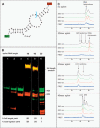Optimizing splinted ligation of highly structured small RNAs
- PMID: 16251384
- PMCID: PMC1370878
- DOI: 10.1261/rna.2170705
Optimizing splinted ligation of highly structured small RNAs
Abstract
The synthesis of highly structured small RNAs containing nonstandard nucleotides is of high interest for structural and functional investigations. A general approach is the joining, by T4 DNA ligase-mediated splinted ligation, of two or more RNA fragments, each of which may contain its own set of modified nucleotides. The RNA fragments hybridize with a complementary DNA splint to form a ternary ligation-competent-complex (LCC), which is then turned over by the DNA ligase. We studied the formation of the LCC and its precursors using size exclusion chromatography combined with a fluorescence detector. The spatial proximity of two cyanine-dye-labeled RNA fragments in LCCs was detected by monitoring FRET. An observed correlation of LCC formation and ligation yields suggests the use of long splints to stabilize LCCs. Splint oligos of increasing length, which in general appear to reduce the number of different hybridization intermediate species found in a reaction mixture, were applied to the synthesis by T4-DNA-ligation of two highly structured target molecules, one a 73 mer tRNA, the other a 49 mer synthetic ribozyme. A stable LCC could be isolated and turned over with>95% ligation efficiency. In conclusion, the use of long splints presents a generally applicable means to overcome the low propensity of highly structured RNAs for hybridization, and thus to significantly improve ligation efficiencies.
Figures


Similar articles
-
Efficient splinted ligation of synthetic RNA using RNA ligase.Methods Mol Biol. 2014;1126:137-49. doi: 10.1007/978-1-62703-980-2_10. Methods Mol Biol. 2014. PMID: 24549661
-
Template-directed ligation of tethered mononucleotides by t4 DNA ligase for kinase ribozyme selection.PLoS One. 2010 Aug 24;5(8):e12368. doi: 10.1371/journal.pone.0012368. PLoS One. 2010. PMID: 20811490 Free PMC article.
-
Oligoribonucleotide circularization by 'template-mediated' ligation with T4 RNA ligase: synthesis of circular hammerhead ribozymes.Nucleic Acids Res. 1998 May 15;26(10):2502-4. doi: 10.1093/nar/26.10.2502. Nucleic Acids Res. 1998. PMID: 9580707 Free PMC article.
-
DNA and RNA ligases: structural variations and shared mechanisms.Curr Opin Struct Biol. 2008 Feb;18(1):96-105. doi: 10.1016/j.sbi.2007.12.008. Epub 2008 Feb 8. Curr Opin Struct Biol. 2008. PMID: 18262407 Review.
-
Ligation-based DNA diagnostics.Bioessays. 1993 Nov;15(11):761-5. doi: 10.1002/bies.950151112. Bioessays. 1993. PMID: 8292008 Review.
Cited by
-
Characterizing the dynamics of the leader-linker interaction in the glycine riboswitch with site-directed spin labeling.Biochemistry. 2014 Jun 10;53(22):3526-8. doi: 10.1021/bi500404b. Epub 2014 May 28. Biochemistry. 2014. PMID: 24849816 Free PMC article.
-
Chemical synthesis of long RNAs with terminal 5'-phosphate groups.Chemistry. 2017 Apr 19;23(22):5210-5213. doi: 10.1002/chem.201700514. Epub 2017 Mar 29. Chemistry. 2017. PMID: 28295757 Free PMC article.
-
An RNA toolbox for single-molecule force spectroscopy studies.Nucleic Acids Res. 2007;35(19):6625-39. doi: 10.1093/nar/gkm585. Epub 2007 Sep 28. Nucleic Acids Res. 2007. PMID: 17905817 Free PMC article.
-
Mg2+-dependent folding of a Diels-Alderase ribozyme probed by single-molecule FRET analysis.Nucleic Acids Res. 2007;35(6):2047-59. doi: 10.1093/nar/gkm072. Epub 2007 Mar 7. Nucleic Acids Res. 2007. PMID: 17344321 Free PMC article.
-
Use of DNAzymes for site-specific analysis of ribonucleotide modifications.RNA. 2008 Jan;14(1):180-7. doi: 10.1261/rna.742708. Epub 2007 Nov 12. RNA. 2008. PMID: 17998290 Free PMC article.
References
-
- Edwards, T.E. and Sigurdsson, S.T. 2005. Modified RNA as tools in RNA biochemistry. In Handbook of RNA biochemistry (eds. R.K. Hartmann et al.), pp. 112–128. Wiley, Weinheim, Germany.
-
- Frilander, M.F. and Turunen, J.J. 2005. RNA Ligation using T4 DNA ligase. In Handbook of RNA biochemistry (eds. R.K. Hartmann et al.), pp. 36–52. Wiley, Weinheim, Germany.
-
- Moore, M.J. and Query, C.C. 1998. Use of site-specifically modified RNAs constructed by RNA ligation. In RNA: protein interactions. A practical approach (ed. C.W.J. Smith), pp. 75–108. Oxford University Press, Oxford.
Publication types
MeSH terms
Substances
LinkOut - more resources
Full Text Sources
Other Literature Sources
Miscellaneous
